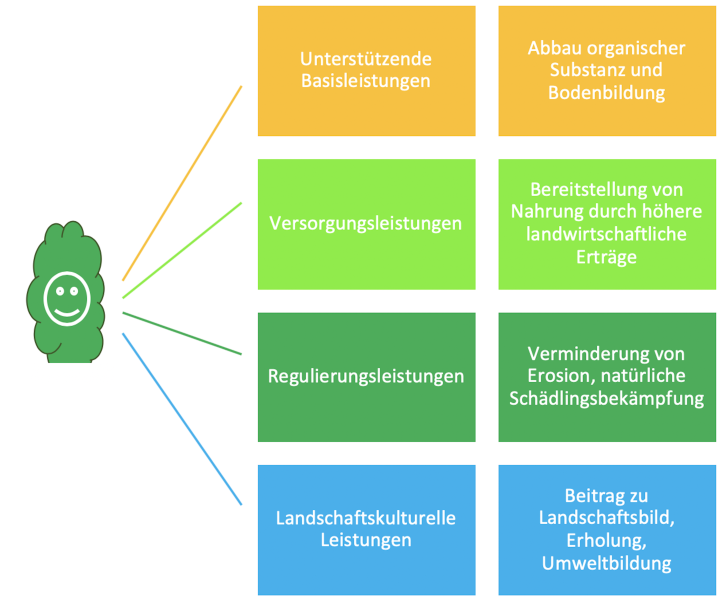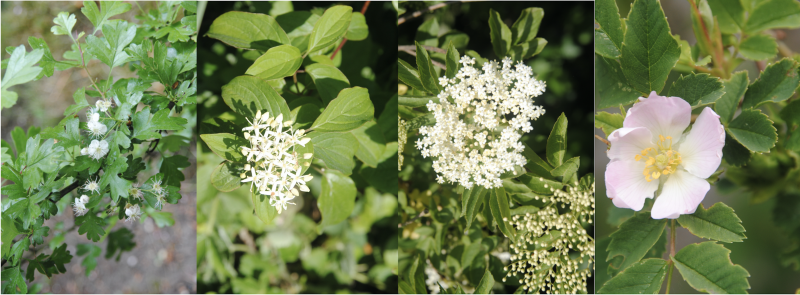Table of Contents
Tree and Hedge - biodiversity in a small space
Hedges: Linear strip of shrubs and trees, habitat for many animal and plant species
Hedges and field shrubs
Hedges and field shrubs are valuable elements of cultural landscapes because they not only provide a splash of colour in agricultural areas, but also offer retreats and food for animal species such as wild bees, yellowhammers, goldfinches, chaffinches, partridges, dormice, rabbits, lizards and many more in a small area. Already in the Middle age, hedges were created and used for fencing and protection of arable land, e.g. for the production of animal food and firewood or to use the fruits of many hedge plants.
Hedges differ in species composition, size, and structure. Well-developed hedges often consist of three zones with typical animals and plants:
- the core zone of larger shrubs with scattered trees,
- the mantle zone with smaller shrubs and
- the hem zone with grasses and herbaceous plants.
Typical plant species of the core zone are hazel, rowan, blackthorn or hawthorn, in the mantle zone species like dog rose, honeysuckle or blackberry can be found (see figure 1). In the mantle zone, light-loving flowering plants such as rain fern and wild field herbs can be found. A hawthorn hedge can also be found here on the outdoor area of the Green FabLab.
Typical hedge plants
The hedge - treasure for biodiversity and mankind
Humans influence ecosystems in many ways, and the effects of human activities on biodiversity and on nutrient cycles (e.g. on nutrient cycles through the use of economic fertilizers, and on the coal cycle through the use of fossil fuels and the associated climate change) are particularly challenging. Hedges can be useful for both challenges. Many studies have shown: Hedges influence the site conditions on adjacent arable land predominantly positive (Figure 2). Hedges and field shrubs offer many benefits, not only in the past they provided important raw materials (wood, hedge snip). They provide wind protection, this is especially important when the soil is not yet covered with crops, in order to avoid loss of fertile arable land (Figure 3).
Right next to the hedge, yields may be somewhat reduced by root competition. This root competition effect can be reduced by placing the hedge on a wall. The positive effects on agricultural yields depend on the distance from the hedge. A positive influence on soil moisture and precipitation is possible up to a harvest that can be many times the height of the hedge.
 |  |
|---|---|
| Fig. 2: Positive effect of the hedge on growth conditions on adjacent areas (adapted according to TEEB 2016) | Fig. 3: Ecosystem services of hedges: multiple benefits of hedges for humans |
Ecosystem services are defined as direct and indirect contributions of ecosystems to human well-being. This refers to services or goods that directly or indirectly provide economic, material, health, or cultural benefits for people (TEEB, 2016). Ecosystem services are assigned to four categories: Basic support services, utility services, regulatory services, and landscape services. cultural achievements. Examples of ecosystem services of hedges are shown in Figure 3.
sources: Naturkapital Deutschland - TEEB DE, 2016. ecosystem services in rural areas - the basis for human well-being and sustainable economic development. Conclusions for decision makers. Leibniz University Hannover, Helmholtz Center for Environmental Research - UFZ, Leipzig).
